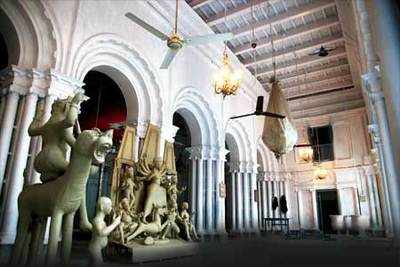Trending
This story is from September 20, 2014
Traditions that speak volumes
Khelat Chandra Ghosh’s mansion has been reverberating with dhak beats and conch strains during Durga Puja for 186 years now, and the celebrations are about to begin

Khelat Chandra Ghosh’s mansion has been reverberating with dhak beats and conch strains during Durga Puja for 186 years now, and the celebrations are about to begin
The Ghosh family
Khelat Bhavan in Pathuriaghata is all decked up in a fresh coat of paint to welcome the goddess. And for its current residents — Pradip Kumar Ghosh, his wife Karabi and eight-year-old son Pradipta Ghosh — Durga Puja is not just a festival; it’s a family tradition that has been around for 186 years now.
The Puja, started by classical music and dance exponent Babu Khelat Chandra Ghosh, is still celebrated in all its traditional grandeur in the mansion that was built by Ghosh in 1844. Pradip Ghosh is his seventh-generation descendant. The family got a place in the pages of history after Ramkrishna Paramhansha visited the house. Rabindranath Tagore, too, had chosen the house as the performing base for the All Bengal Music Conference in 1934. Cricket Association of Bengal president Jagmohan Dalmia is also a son-in-law of the house and visits it every Puja.
A math chauri background, Narasingha as Ma Durga’s bahon and goddess Lakshmi and Saraswati being worshipped as Kamal-Kamini, marked the uniqueness of the Ghosh barir idol, which has been crafted by Madhusudan Pal and his ancestors since its inception. “The idol is inspired by Gangaur Devi of Rajasthan,” said Indrajit Gupta, the family’s spokesperson. Unlike other bonedi baris, Kumari Pujo is done every day. And since animal sacrifice is a strict no-no, sugar substances are sacrificed. Earlier, a Nilkantha bird was released on Dashami but not any more.
Bhog and more
Over 600 people have bhog on the premises every day during Puja. The family, however, doesn’t offer anna bhog. “Ma Durga is treated to a bhog of 51 items on Ashtami that has food cooked at home as well as delicacies from the best sweetshops in town. Betel leaf is offered as well,” Indrajit added. While Saptami has items like chingri malaikari, illish bhapa and illish paturi on the menu, Nabami has mutton biryani for all. A manpower crisis has, however, forced the family to tone down the celebrations.
Biday customs
A seven-gun salute is followed by a royal procession with towering umbrellas and fans, as part of the family’s immersion rituals. “We make sure we leave home by four in the evening. Ma rides on our shoulders to reach the ghat and twin boats are
used for the immersion. Over 40 dhakis are present for the procession. The women of the family need to have fish and paan before bidding maa adieu,” Indrajit said.
The Ghosh family
Khelat Bhavan in Pathuriaghata is all decked up in a fresh coat of paint to welcome the goddess. And for its current residents — Pradip Kumar Ghosh, his wife Karabi and eight-year-old son Pradipta Ghosh — Durga Puja is not just a festival; it’s a family tradition that has been around for 186 years now.
The Puja, started by classical music and dance exponent Babu Khelat Chandra Ghosh, is still celebrated in all its traditional grandeur in the mansion that was built by Ghosh in 1844. Pradip Ghosh is his seventh-generation descendant. The family got a place in the pages of history after Ramkrishna Paramhansha visited the house. Rabindranath Tagore, too, had chosen the house as the performing base for the All Bengal Music Conference in 1934. Cricket Association of Bengal president Jagmohan Dalmia is also a son-in-law of the house and visits it every Puja.
Ritually yours
A math chauri background, Narasingha as Ma Durga’s bahon and goddess Lakshmi and Saraswati being worshipped as Kamal-Kamini, marked the uniqueness of the Ghosh barir idol, which has been crafted by Madhusudan Pal and his ancestors since its inception. “The idol is inspired by Gangaur Devi of Rajasthan,” said Indrajit Gupta, the family’s spokesperson. Unlike other bonedi baris, Kumari Pujo is done every day. And since animal sacrifice is a strict no-no, sugar substances are sacrificed. Earlier, a Nilkantha bird was released on Dashami but not any more.
Bhog and more
Over 600 people have bhog on the premises every day during Puja. The family, however, doesn’t offer anna bhog. “Ma Durga is treated to a bhog of 51 items on Ashtami that has food cooked at home as well as delicacies from the best sweetshops in town. Betel leaf is offered as well,” Indrajit added. While Saptami has items like chingri malaikari, illish bhapa and illish paturi on the menu, Nabami has mutton biryani for all. A manpower crisis has, however, forced the family to tone down the celebrations.
Biday customs
A seven-gun salute is followed by a royal procession with towering umbrellas and fans, as part of the family’s immersion rituals. “We make sure we leave home by four in the evening. Ma rides on our shoulders to reach the ghat and twin boats are
used for the immersion. Over 40 dhakis are present for the procession. The women of the family need to have fish and paan before bidding maa adieu,” Indrajit said.
End of Article
FOLLOW US ON SOCIAL MEDIA









